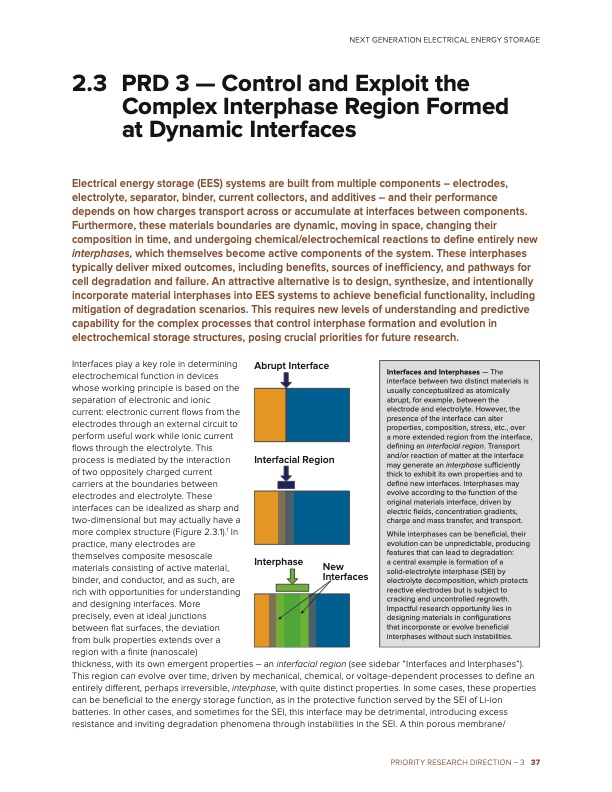
PDF Publication Title:
Text from PDF Page: 043
2.3 PRD 3 — Control and Exploit the Complex Interphase Region Formed at Dynamic Interfaces Electrical energy storage (EES) systems are built from multiple components – electrodes, electrolyte, separator, binder, current collectors, and additives – and their performance depends on how charges transport across or accumulate at interfaces between components. Furthermore, these materials boundaries are dynamic, moving in space, changing their composition in time, and undergoing chemical/electrochemical reactions to define entirely new interphases, which themselves become active components of the system. These interphases typically deliver mixed outcomes, including benefits, sources of inefficiency, and pathways for cell degradation and failure. An attractive alternative is to design, synthesize, and intentionally incorporate material interphases into EES systems to achieve beneficial functionality, including mitigation of degradation scenarios. This requires new levels of understanding and predictive capability for the complex processes that control interphase formation and evolution in electrochemical storage structures, posing crucial priorities for future research. Interfaces play a key role in determining electrochemical function in devices whose working principle is based on the separation of electronic and ionic current: electronic current flows from the electrodes through an external circuit to perform useful work while ionic current flows through the electrolyte. This process is mediated by the interaction of two oppositely charged current carriers at the boundaries between electrodes and electrolyte. These interfaces can be idealized as sharp and two-dimensional but may actually have a more complex structure (Figure 2.3.1).1 In practice, many electrodes are themselves composite mesoscale materials consisting of active material, binder, and conductor, and as such, are rich with opportunities for understanding and designing interfaces. More precisely, even at ideal junctions between flat surfaces, the deviation from bulk properties extends over a region with a finite (nanoscale) thickness, with its own emergent properties – an interfacial region (see sidebar “Interfaces and Interphases”). This region can evolve over time, driven by mechanical, chemical, or voltage-dependent processes to define an entirely different, perhaps irreversible, interphase, with quite distinct properties. In some cases, these properties can be beneficial to the energy storage function, as in the protective function served by the SEI of Li-ion batteries. In other cases, and sometimes for the SEI, this interface may be detrimental, introducing excess resistance and inviting degradation phenomena through instabilities in the SEI. A thin porous membrane/ Abrupt Interface Interfacial Region NEXT GENERATION ELECTRICAL ENERGY STORAGE Interfaces and Interphases — The interface between two distinct materials is usually conceptualized as atomically abrupt, for example, between the electrode and electrolyte. However, the presence of the interface can alter properties, composition, stress, etc., over a more extended region from the interface, defining an interfacial region. Transport and/or reaction of matter at the interface may generate an interphase sufficiently thick to exhibit its own properties and to define new interfaces. Interphases may evolve according to the function of the original materials interface, driven by electric fields, concentration gradients, charge and mass transfer, and transport. While interphases can be beneficial, their evolution can be unpredictable, producing features that can lead to degradation: a central example is formation of a solid-electrolyte interphase (SEI) by electrolyte decomposition, which protects reactive electrodes but is subject to cracking and uncontrolled regrowth. Impactful research opportunity lies in designing materials in configurations that incorporate or evolve beneficial interphases without such instabilities. Interphase Interfaces New PRIORITY RESEARCH DIRECTION – 3 37PDF Image | Next Generation Electrical Energy Storage

PDF Search Title:
Next Generation Electrical Energy StorageOriginal File Name Searched:
BRN-NGEES_rpt-low-res.pdfDIY PDF Search: Google It | Yahoo | Bing
Sulfur Deposition on Carbon Nanofibers using Supercritical CO2 Sulfur Deposition on Carbon Nanofibers using Supercritical CO2. Gamma sulfur also known as mother of pearl sulfur and nacreous sulfur... More Info
CO2 Organic Rankine Cycle Experimenter Platform The supercritical CO2 phase change system is both a heat pump and organic rankine cycle which can be used for those purposes and as a supercritical extractor for advanced subcritical and supercritical extraction technology. Uses include producing nanoparticles, precious metal CO2 extraction, lithium battery recycling, and other applications... More Info
| CONTACT TEL: 608-238-6001 Email: greg@infinityturbine.com | RSS | AMP |